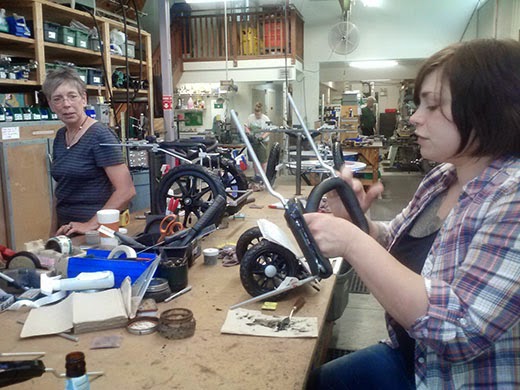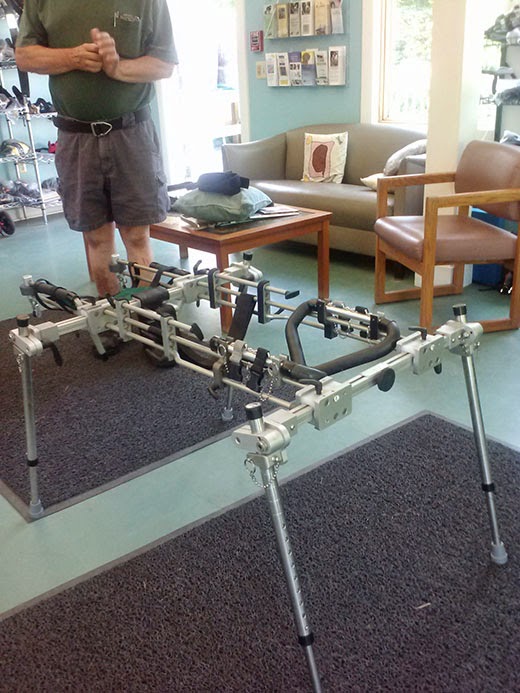It’s all about guiding and empowering you to help your pet avoid injury, provide practical solutions and achieve rapid restoration of health and function!
Here is the promised list of several major wheeled cart companies.
Eddie’s Wheels for Pets
www.eddieswheels.com
Remember the famous line delivered by Renee Zellweger in Jerry Maguire: ….. “You had me at hello”..? Well, they had me way before hello. I met Leslie Grinnell, co-owner and wife of Eddie, in person at an animal rehabilitation conference in 2013 and bonded with this lovely woman instantly.
I have since traveled to their facility in Shelburne Falls, MA, spent quality time with Leslie and Eddie, toured the shop, met their employees, and received expert instructions on making cart adjustments. I’m a fan. But long before this I was convinced of their product’s superiority through experience ordering them for patients and seeing the beautiful design, quality and workmanship. Eddie Grinnell, a mechanical engineer, combined his expert skills with love of pets to invent a cart design which is closely aligned to the dog’s center of gravity and natural axis of motion at the hip and shoulder joints. This is very important in helping accurately mimic the pet’s normal movement and prevent pulling or strain.
The cart frame is made of solid aluminum, being durable yet light weight, with stainless steel set screws and wheel fittings. Eddie’s has a welded, padded saddle uniquely designed for various breeds to match the shape and angle of their pelvis, and provide comfortable support for the pelvic floor. Careful measurements are required, but can be taken by the family, veterinarian or therapist. Carts are fully adjustable, using some basic tools.
Are there any negatives to consider with Eddie’s Wheels? Honestly, no. Some folks might not like waiting 2-3 weeks for their cart to arrive, but after observing the effort and precision that goes into each one, it’s worth it. The carts are just a bit heavier than others’ (while being lightweight overall) but this would only be an issue with extremely frail dogs.
 |
| New developments at Eddie’s Wheels: Wheeled Walkers designed for smaller pets under 30 pounds, who need light, full-body support for their mobility. |
www.K9Carts.com
K9 Carts' cart is designed by a veterinary surgeon, which seems like a good thing, but I remain convinced that engineers trump vets or therapists in the creation and building of mechanical equipment.
The carts are bulky and the frame is made with tubular aluminum (not solid). Support straps and leg rings are made with nylon webbing material which I find to be thin and not super supportive. The company is veterinarian owned and operated.
Doggon Wheels
www.doggon.com
A positive feature is their cart being very light weight, which might be desired for an extremely frail or delicate pet. However the design, using high side bars, is not centered along the animal’s natural midline. The wheels are offset and placed widely apart, instead of closely aligned to the body.
Walkin Wheels
www.handicappedpets.com/walkinwheels
The design is, well, awkward. The frame materials are not the highest quality and the stirrups and support straps are of soft, loose construction. Carts are prefabricated, not custom built. There is just one easy measurement and the carts ship quickly, but the client must self- assemble (no tools required). Some of the materials used for the carts are from China.
They don’t try to hide that fact, and it may not matter to you, but it’s worth noting. The company touts their product as being environmentally friendly and easy to re-use on other pets. I would be more concerned with durability over disposability or ease of re-use! I am not a fan of their carts; however the parent company Handicapped Pets, carries some very good products for other aspects of disability pet care.
Dewey’s Wheelchairs for Dogs
www.wheelchairsfordogs.com
Dewey’s Wheelchairs for Dogs uses light- weight plastic materials. Their support straps are quite thin and look as if they will cause discomfort.
Ruff Rollin Wheels
www.ruffrollin.com
I like the design and workmanship of these aluminum based custom built carts. I rate them as ‘the best of the rest’.
Best Friend Mobility carts
www.bestfriendmobility.org
Very simple but rather rudimentary design. They are light weight and feature a lower cost than other carts.
Final considerations
Recycled carts
Some companies will accept used carts when a pet no longer needs them or dies, and might modify them for other pets whose family has a financial burden. The donor can experience deep satisfaction in knowing their dog’s cart has become a legacy for another deserving pet.
Do-it-Yourself carts
Though I admire the spirit and creativity behind those “self-builders’ of the world, there is real risk of injury (strain, overuse) to your pet. Consider this option only if you have no other choice and the cart is strictly for temporary or short-term use. Use every resource you can to buy a cart from a reputable company before attempting to build it on your own.
When not to use a cart
There are instances when I do not recommend carts such as: when a pet is just not motivated to be mobile (rare), when a pet owner is not physically capable of handling the cart or placing their pet within, when potential exertion may cause undue medical risk, when a dog is in pain or is fearful of the cart, the financial expense versus predicted longevity of dog’s lifespan, etc.
***
 Susan
E. Davis (Sue) is a licensed Physical Therapist with over 30
years of practice in the human field, who transitioned into the
animal world after taking courses at the UT Canine Rehabilitation
program. She is located in Red Bank, New Jersey.
Susan
E. Davis (Sue) is a licensed Physical Therapist with over 30
years of practice in the human field, who transitioned into the
animal world after taking courses at the UT Canine Rehabilitation
program. She is located in Red Bank, New Jersey.She has been providing PT services to dogs and other animals through her entity Joycare Onsite, LLC in pet’s homes and in vet clinics since 2008.
She also provides pro bono services at the Monmouth County SPCA in Eatontown, NJ. Sue is the proud “dog mommy” to Penelope, a miniature Dachshund with “attitude”. For more information see her website www.joycareonsite.com , or follow on Twitter @animalPTsue.
Sue is also the author of a fantastic book on physical therapy, Physical Therapy And Rehabilitation For Animals: A Guide For The Consumer.
Physical therapy can do so many great things for your dog. Understanding all the possibilities physical therapy can offer will change your dog's life. This book definitely belongs on the shelf of every dog lover.
Articles by Susan E. Davis:
Functional Strengthening Exercises: the What, Why and How
One Thing Leads To Another: Why The Second ACL Often Goes Too
Compensation: An Attempt To Restore Harmony
Paring Down to the Canine Core
Canine Massage: Every Dog ‘Kneads’ It”
Photon Power: Can Laser Therapy Help Your Dog?
Physical Therapy in the Veterinary World
Reiki: Is it real?
Dog Lessons: Cooper
The Essentials Of Canine Injury Prevention: 7 Tips For Keeping Your Dog Safer
The Challenge Of Degenerative Myelopathy (DM): Knowledge Is Power (Part I)
Degenerative Myelopathy (DM): Top 10 Management Suggestions (Part II)
Great (Or Not So Great) Expectations with Femoral Head Osteotomy (FHO) Part (I)
Great (Or Not So Great) Expectations with Femoral Head Osteotomy (FHO) Part (II)
It's Not Just Walking, It's Therapy! Degenerative Myelopathy (DM): Top 10 Management Suggestions (Part II)
Great (Or Not So Great) Expectations with Femoral Head Osteotomy (FHO) Part (I)
Great (Or Not So Great) Expectations with Femoral Head Osteotomy (FHO) Part (II)
Treatment And Prevention Of Canine Intervertebral Disc Disease (Part I)
Treatment And Prevention Of Canine Intervertebral Disc Disease (Part II Physical Therapy)
Range Of Motion: It’s A Matter Of Degree…
The Weight Of Water And How It Helps Dogs
By Land or By Sea? A Comparison of Canine Treadmills
Unraveling The Mystery Of Fascia And Myofascial Trigger Points (Part I)
Unraveling The Mystery Of Fascia And Myofascial Trigger Points (Part II)
Scar Tissue: Is it Too Much of a Good Thing?
Physical Therapy Tip Of The Month: Ramps!
Physical Therapy Tip Of The Month: Indoor Duo Dog Exercises!
Physical Therapy Tip Of The Month: Best Practices After Your Dog’s Surgery
Physical Therapy Tip Of The Month: Ideas to Chew on - Can Physical Therapy Help with my Dog’s Digestive Problems?
Wrap It Up: Using Soft Supports For Your Dog
When Do I Use Heat versus Cold? : A Tale (or Tail) Of Two Temps! (Part I)
When Do I Use Heat versus Cold? : A Tale (or Tail) Of Two Temps! (Part II)
Physical Therapy Tip Of The Month: Safe Summer Boating Tips for your Dog
Physical Therapy Tip Of The Month: Hip Dysplasia - What’s a Dawg Mama to Do?
PT Pit Stop: Wheeled Carts Keep Them Doggies Rollin' (Part I)





So great to see this! So many people think that older dogs should be "put out of their misery" when they can't walk perfectly, but plenty of dogs can enjoy many more happy years with a little help and adjustment. :)
ReplyDelete